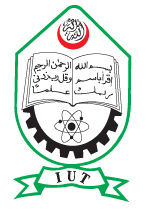Processing Sections
Processing Section
The processing section holds a pivotal role within the library, acting as a bridge between internal library operations and the documentation office. Its primary function is to prepare library resources for usability, adhering to established standards and formats such as AACR2, MARC21, and other recognized tools. This multifaceted department is entrusted with various crucial tasks, all geared toward the organization and upkeep of library materials and services.
Services and facilities of this section
The services and functions of this section includes:
Acquisition: The processing section receives and records newly acquired library materials, such as books, magazines, and multimedia items. This involves checking shipments, verifying orders, and ensuring that the library's collection aligns with its acquisition policies.
Cataloging: Library staff classify and catalog materials, assigning them unique call numbers, subject headings, and other metadata to facilitate easy access and retrieval for patrons. This ensures that items are organized systematically and can be located efficiently.
Labeling and Barcoding: Each item is affixed with a barcode label and other identifying markers to streamline the check-out and check-in processes. These labels help in tracking the movement of materials and enhancing security
Repair and Maintenance: The section includes facilities for repairing damaged items, from bookbinding to replacing worn-out covers, thereby extending the lifespan of library materials and reducing the need for replacement.
Data Entry: Library staff input information about new acquisitions into the library's electronic database (KOHA), including details like author, title, publication date, and ISBN/ISSN numbers, ensuring that the catalog is up to date.
Weeding and Withdrawal: Materials that are outdated, damaged beyond repair, or no longer relevant to the library's collection are identified and withdrawn. The processing section may also handle the disposal of these items or send them to surplus sales.
Re-shelving: Once materials are processed, they are prepared for placement on the library shelves, following established classification systems like the Dewey Decimal System or Library of Congress Classification.
News Clippings: For libraries maintaining collections of news clippings, this section may manage the organization, indexing, and storage of these clippings for easy retrieval by researchers and patrons.
Archiving: Materials that need to be archived for historical or reference purposes, such as rare books or historical documents, are preserved and stored properly in the archives within the processing section.
Managing Library Clearance: This function involves managing the clearance of fines and overdue materials, as well as assisting patrons with account-related issues and helping them regain borrowing privileges.
Undergraduate and Graduate Thesis Management: The processing section may oversee the organization and maintenance of undergraduate and graduate theses. This includes cataloging, indexing, and providing access to these academic works for research and reference.
Settlement of Lost Items: When library materials are declared lost by patrons, the processing section manages the process of settling fines or replacement costs and updating the circulation records.
Acquisition: The processing section receives and records newly acquired library materials, such as books, magazines, and multimedia items. This involves checking shipments, verifying orders, and ensuring that the library's collection aligns with its acquisition policies.
Cataloging: Library staff classify and catalog materials, assigning them unique call numbers, subject headings, and other metadata to facilitate easy access and retrieval for patrons. This ensures that items are organized systematically and can be located efficiently.
Labeling and Barcoding: Each item is affixed with a barcode label and other identifying markers to streamline the check-out and check-in processes. These labels help in tracking the movement of materials and enhancing security
Repair and Maintenance: The section includes facilities for repairing damaged items, from bookbinding to replacing worn-out covers, thereby extending the lifespan of library materials and reducing the need for replacement.
Data Entry: Library staff input information about new acquisitions into the library's electronic database (KOHA), including details like author, title, publication date, and ISBN/ISSN numbers, ensuring that the catalog is up to date.
Weeding and Withdrawal: Materials that are outdated, damaged beyond repair, or no longer relevant to the library's collection are identified and withdrawn. The processing section may also handle the disposal of these items or send them to surplus sales.
Re-shelving: Once materials are processed, they are prepared for placement on the library shelves, following established classification systems like the Dewey Decimal System or Library of Congress Classification.
News Clippings: For libraries maintaining collections of news clippings, this section may manage the organization, indexing, and storage of these clippings for easy retrieval by researchers and patrons.
Archiving: Materials that need to be archived for historical or reference purposes, such as rare books or historical documents, are preserved and stored properly in the archives within the processing section.
Managing Library Clearance: This function involves managing the clearance of fines and overdue materials, as well as assisting patrons with account-related issues and helping them regain borrowing privileges.
Undergraduate and Graduate Thesis Management: The processing section may oversee the organization and maintenance of undergraduate and graduate theses. This includes cataloging, indexing, and providing access to these academic works for research and reference.
Settlement of Lost Items: When library materials are declared lost by patrons, the processing section manages the process of settling fines or replacement costs and updating the circulation records.


